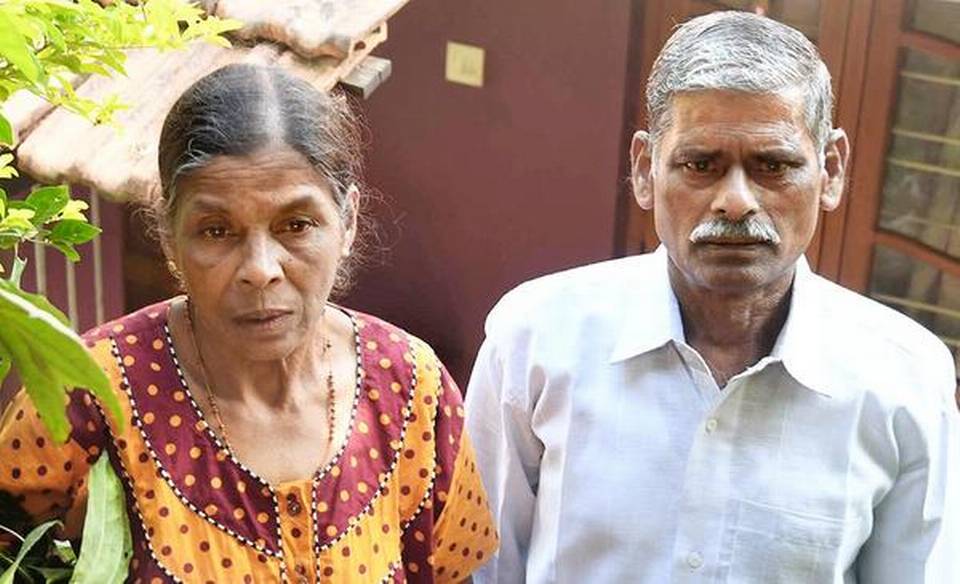
The landscape bears the wounds of the devastating deluge; families, worried about the future, are wary of returning home.
A river, brown with muddy water, flows its usual course on a sunny afternoon, deceptive of the ravage it had caused two months ago when heavy rains and floods devastated Kodagu. On one side of the river’s bank sit two houses – both with different stories of the same tragedy.
One bears large cracks on the walls. Dominic, 63, and his wife Apolimanthera, 59, had to flee from their home in Hattihole, Kodagu district, for a week, after the water level rose on August 17, inundating their home that is below road level. “The water was up to our waist on the road, and we were asked to rush out. We stayed at the relief centre set up in the church for around a week and returned to the devastation after the levels receded,” Mr. Dominic said.
Pointing to a large tree that was swept away by the force of water, which now stands as testimony to the extent of the disaster in the middle of the river, visible from their backyard, he lamented that the river water was now unfit to be used for anything.
Next door, within the same compound is the house of Francis Montheiro, 47, now locked up. A social worker, Mr. Montheiro, known as Appu, was an active volunteer during the floods too. Mr. Dominic last saw him on the morning of August 17, after which he went missing. His body was found in the river nine days later.
Mr. Montheiro’s wife Flaviya Jyothi, 44, a nurse at a private hospital in Madikeri, and two children have shifted to the capital. “My husband used to pick up and drop me halfway. But now, with my shift timings, I decided to shift to Madikeri to make travel easier,” she said. Their sons are in Class 10. Mr. Monteiro was engaged in small businesses dealing with pepper and coffee and drove a taxi.
The house they have left behind, Ms. Jyothi said, is the only asset the family has. “We received ₹5 lakh in compensation. But how do you make up for the loss of a person? Appu is now only a name in our memories,” she added.
Francis D’Souza runs a small hotel on the main road that leads to Hattihole. Having lost his house in the flood, he now lives in a house on rent. “Not just our house, when we left for the relief centre, someone stole what was left in the house and the hotel – jewellery, homemade wine, and bottles of honey (which he sells) and sacks of pepper,” he said.
Three months after the floods, signs of devastation are still everywhere. In Thantipala, the van of a local resident lies almost fully buried in sand left behind by flood water. Mounds of flood residue comprising mud and broken trees line up either side of the road paved out.
In Udaygiri, the remains of the sole house that survived a massive landslip hinges on the edge, as locals continue to stream in, standing cautiously on the other side and trying to remember the road that once led straight to that house. Raghavendra Shetty, a school teacher, said one person had died here, and at least five houses had turned into rubble.
Normalcy is still a far cry for these families.
Says Ms. Apolimanthera, with large coffee estates being wiped out, work as an estate worker was hard to come by. “I used to earn around ₹1,800 a week. Now I am lucky if I find enough work to pay me ₹300 a day. In our 50 years here, we have never been faced with anything like this,” she said.
Apart from dealing with coming to terms with the present, many are worried about the future.
Charan Panthale drives down to his field in Devasthur, where his house stands half destroyed. A large tree trunk, brought in by the gush of water that crashed into his house, still stands. Sacks of husk lie outside the house on a bed of mud that was the land it was harvested in.
“We have lost one and a half acres. There is nothing we can do about it at present. It will take a long time,” he said. The family is temporarily living with relatives.
840 beneficiaries in the first phase
The Kodagu district administration has identified 840 beneficiaries who will be given houses in the first phase. The government will approve one of the five model houses being built by different agencies and companies.
Sreevidya P.I., Deputy Commissioner, Kodagu, told The Hindu that the report had been submitted to the government and awaited approval. The beneficiaries were chosen based on applications and cross verification with agencies such as the gram panchayats.
“There are five houses and three have been completed. The Chief Minister has also seen these. New technology has been tried out in these. We will see which of these is suitable for the hilly terrain and landslips and accordingly, one model will be selected,” she said.
The DC also said that some people had expressed willingness to build houses on their own, for which the government would provide some compensation, and they too could utilise the technology implemented in the model houses. The unit cost is yet to be decided, she said.
As for crop losses, a hectare-wise compensation based on the type of plantation – coffee, paddy, pepper, etc –would be initiated , Ms. Sreevidya said, adding that NDRF guidelines were followed for the surveys, and with Union government funds involved, they would have to wait for government approval.
(This is the first of a two-part series.)
source: http://www.thehindu.com / The Hindu / Home> News> States> Karnataka / by K.C. Deepika / November 17th, 2018

